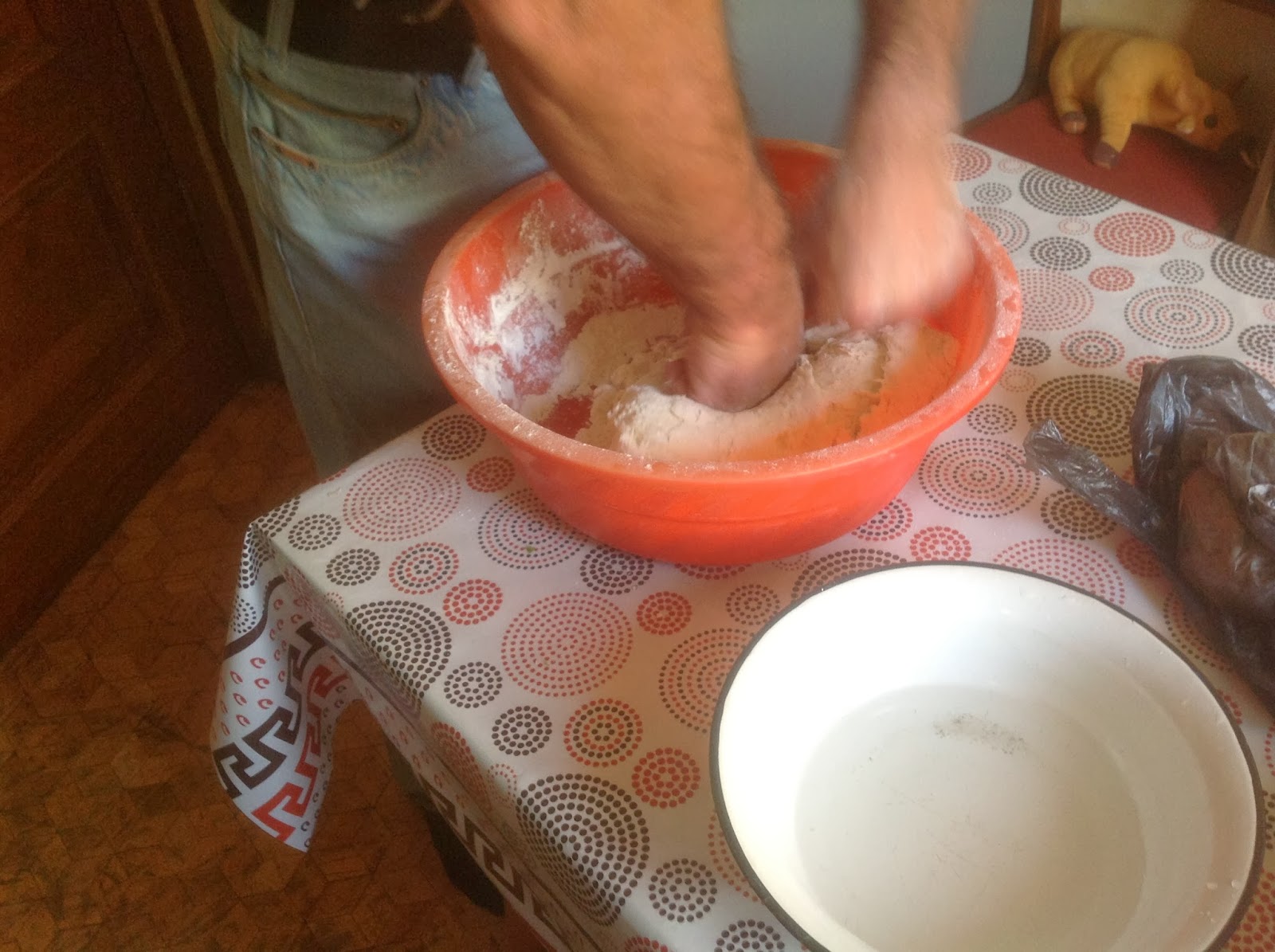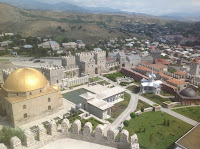Driving in Tbilisi can mean taking your life into your own hands, or, better yet, placing it in the middle of the road, and hoping you make it home in one piece...
 I first started driving in Georgia in February 2008, at night, during a snow rain storm. Needless to say, it was an interesting first approach..You see, in Batumi, where I entered at that time, the main road improvements had not yet been done as they are nowadays, and there were still some MAJOR holes in the road. I had just survived a huge snow storm in Turkey, been stuck in Istambul under a couple of meters of snow, so I thought I had seen the worse part...and I had, frankly.
I first started driving in Georgia in February 2008, at night, during a snow rain storm. Needless to say, it was an interesting first approach..You see, in Batumi, where I entered at that time, the main road improvements had not yet been done as they are nowadays, and there were still some MAJOR holes in the road. I had just survived a huge snow storm in Turkey, been stuck in Istambul under a couple of meters of snow, so I thought I had seen the worse part...and I had, frankly.Here is the Justice Building, just in case the road gets the better of you..
You can tell the roads are quite large in Tbilisi. It is actually well marked, it is all made for normal, civilized driving. But civilized driving, it isn't. I always said that the Georgians are excellent drivers, but crazy nuts drivers. Let's say that driving in Tbilisi is a challenge to any human being in his right mind...If the cars don't get you, the pollution will, at this point. The government is trying to remedy the problem (2018 update) by eliminating the old cars and busses, the smoky mini-vans, etc.
This is the road that led to Batumi that day in Feb. 2008. It is actually what I drove in Turkey for hundreds of miles before arriving in Batumi. It was then that I was told that, in case of rain, you never, never drive in a puddle. Why is that? Well, I found out that the manhole covers can sometimes disappear, and you end up with a puddle the size of...a manhole cover, and just as deep. You can just imagine the rest..30 minutes into Georgia, I had fallen into one, which allowed me to understand the Georgian welcome. Within an hour, I had been fed, the car towed to a nearby hotel parking, a room found, a khatchapuri eaten...Yes, now I got it.. but, frankly, it was one of the best moments of my life. The one when I saw the power of solidarity..
 In Georgia, the streets are quite large. Actually, they are large enough for 2 tanks to come through! That is the description I was given, and I found that to be a great image, even if it is just a visual for me, and a large amount of memories, not all that positive, for my Georgian friends...Here in Varketili, one of the neighborhoods a bit away from the center, you can walk in the streets, but beware! If you hear a motor, look quickly around you!
In Georgia, the streets are quite large. Actually, they are large enough for 2 tanks to come through! That is the description I was given, and I found that to be a great image, even if it is just a visual for me, and a large amount of memories, not all that positive, for my Georgian friends...Here in Varketili, one of the neighborhoods a bit away from the center, you can walk in the streets, but beware! If you hear a motor, look quickly around you!
The police are quite present in Georgia these days. The system was completely redone when Saakashvili came to power. The officers are young, and do not take any bribes. At least, that is the ongoing thought. I have never felt anything but safe in Georgia. I cannot say the same for the Paris underground... There are a lot of cars, but they drive, albeit fast, but extremely well. Did I mention car insurance is just a notion here? On my arrival from France, I really wanted to insure my car...Why, they said? Nobody does...That would be exactly why, and the fact that once back in Europe, that would be the first question from the French insurance agent..It was cheap, and it was ..available!
 The streets in Georgia are getting much better, but it is not unusual to see gaping holes. Partly, because the street has not be renovated, or, because it has been, and the job was maybe not perfect, and also, because the earth moves a lot in Georgia...It is getting better. This pic dates from 2008. The streets in disarray, a reflection of the country somewhat, and the mink coat, symbol that they keep that inner beauty...The Georgians have that beauty, inside and out..don't let the streets fool you..
The streets in Georgia are getting much better, but it is not unusual to see gaping holes. Partly, because the street has not be renovated, or, because it has been, and the job was maybe not perfect, and also, because the earth moves a lot in Georgia...It is getting better. This pic dates from 2008. The streets in disarray, a reflection of the country somewhat, and the mink coat, symbol that they keep that inner beauty...The Georgians have that beauty, inside and out..don't let the streets fool you..
Here, the new cars...and the old cars... Guess the make of the light colored car!

Plenty of room on that street, with a marshootka in the background..This side pic shows that even in newer paving, the holes arrive quickly..
So, go ahead, drive in Georgia! They tell me I am crazy, as a French woman, to attempt it, but my answer is always: "I drove at noon, on the bridge between Europe and Asia in Istambul, and in the streets of San Francisco in the cold winter chill. I can drive ANYWHERE!"
2014:
Funny how you think you can drive anywhere, drive like the locals, and be just fine...
I guess it is ok if you don't drive like a Georgian in front of the police AND with foreign plates. The plates are a sure way to get yourself ticketed. I can drive like Georgians in our Georgian-plated car there, do all kinds of funky maneuvers, and somehow, nothing happens...BUT...
and this is where, you guessed it, I got stopped.
Oh, yes, I was following oodles of Georgians, who were passing trucks, cutting the solid white line, and speeding in town. So, I thought: "Ok, these trucks can be passed without any problem. No one coming the other way, no problem. I followed suit on the dozen or so cars that had done the same thing just in front of me. Except that the cops saw only me, a cute French little lady, and my load of tourists in the back seat! How do you spell "Score!"...??
They took my passport, told me to wait, totally disregarded my Georgian husband telling them that I was doing the same as everyone, and asked me for my French telephone number..Went back to their patrol car, and we waited for a good 30 minutes..Then, the verdict was in: 1.my phone number didn't work(well, duh, there is an international code, sir...) and 2. I needed a ticket because "I looked like I was afraid of them". Believe it or not, that was the reason for my ticket! I looked guilty! Whatever...
How much? About 25 US$, or 50 GEL. Not too bad, and I paid it the next day. You go into any bank, and give them the ticket, and pay it, and the nastiness is over..Please know that if you do not pay your ticket, you will NOT be able to get out of the country in plane, or car..The police system is well organized. You will need the receipt to show that you paid on your way out!
The moral of the story? Don't drive with foreign plates in Georgia,or you will be a "driving duck"
Thanks, Officer!!
So glad you came to visit. Please feel free to leave a comment.
Contact Giga on his Facebook page
for a fun travel time in Georgia.
or message us directly at:
Menu Voyage
Menu Voyage
















































